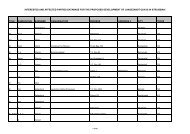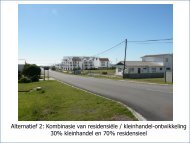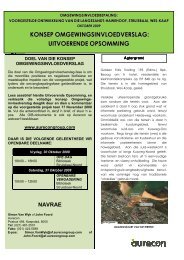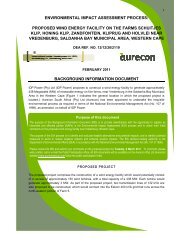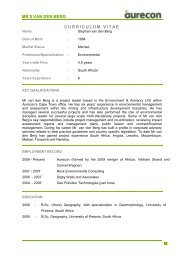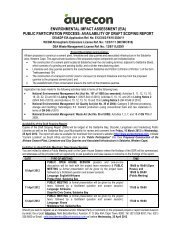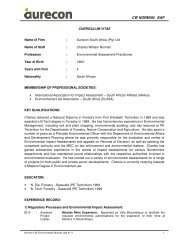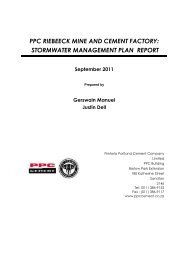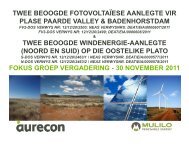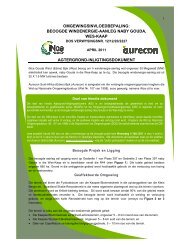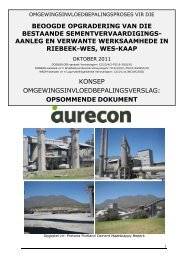Final EIAR - Aurecon AME Environmental | Environmental Projects
Final EIAR - Aurecon AME Environmental | Environmental Projects
Final EIAR - Aurecon AME Environmental | Environmental Projects
You also want an ePaper? Increase the reach of your titles
YUMPU automatically turns print PDFs into web optimized ePapers that Google loves.
Proposed Wind and Solar (Photovoltaic) Energy Facilities on Kangnas Farm near Springbok in the Northern Cape: <strong>Final</strong> EIR 41<br />
Where no new PPA can be negotiated it is likely that the wind farm would be decommissioned<br />
according to requirements in the EMP and as required by any other legislation/regulations at<br />
that time.<br />
The following decommissioning and/or repowering activities have been considered to form part<br />
of the project scope of the proposed wind energy facility:<br />
a) Site preparation<br />
Site preparation activities would include confirming the integrity of the access to the site to<br />
accommodate required equipment and lifting cranes, preparation of the site (e.g. lay down<br />
areas, construction platform) and the mobilisation of decommissioning equipment.<br />
b) Disassemble and replace existing turbines<br />
A large crane would be brought on site. It would be used to disassemble the turbine and tower<br />
sections. These components would be reused, recycled or disposed of in accordance with<br />
regulatory requirements. All parts of the turbine would be considered reusable or recyclable<br />
except for the blades. The land-use would revert back agriculture/ grazing.<br />
3.3 SOLAR ENERGY FACILITY PROJECT<br />
PV systems convert sunlight into energy. The smallest unit of a PV installation is a cell. The PV<br />
cells are made of silicone which acts as a semi-conductor. The cells absorb light energy which<br />
energizes the electrons to produce electricity. A number of solar cells electrically connected to<br />
each other and mounted in a support structure or frame, behind a glass sheet to protect the<br />
cells from the environment, is called a PV module. A number of cells form a module and a<br />
number of modules form an array (see Figure 3.6). Modules are arranged in section sizes of<br />
approximately 40 x 5 m called tables and are installed on racks which are made of aluminum or<br />
steel. Modules are designed to supply electricity at a certain voltage. The current produced is<br />
directly dependent on how much light strikes the module. The arrays are arranged into rows that<br />
form the solar field.<br />
© <strong>Aurecon</strong> (2012) No unauthorised reproduction, copy<br />
or adaptation, in whole or in part, may be made.<br />
P:\<strong>Projects</strong>\108495 Kangnas WEF & PV EIA's\3 Project Delivery\4 Reports\FEIR\FEIR 210213 <strong>Final</strong>.doc


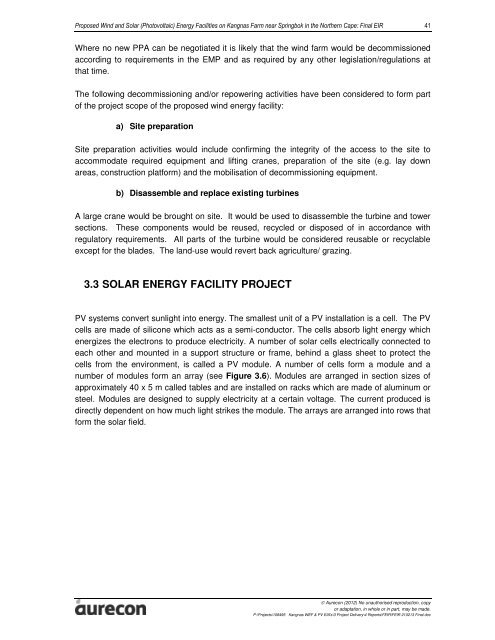
![CRR IV FEIR ~ 26042010 [FINAL].pdf - Environmental Projects](https://img.yumpu.com/21973020/1/184x260/crr-iv-feir-26042010-finalpdf-environmental-projects.jpg?quality=85)
